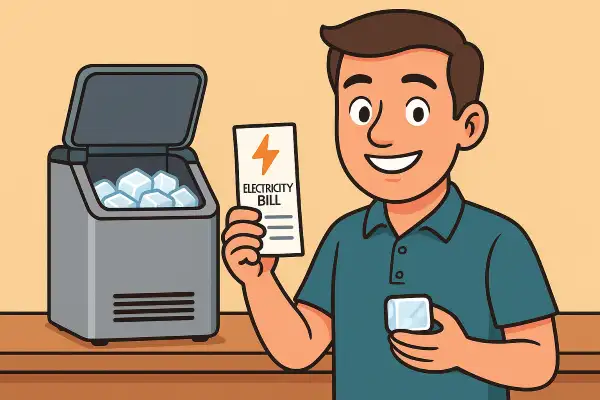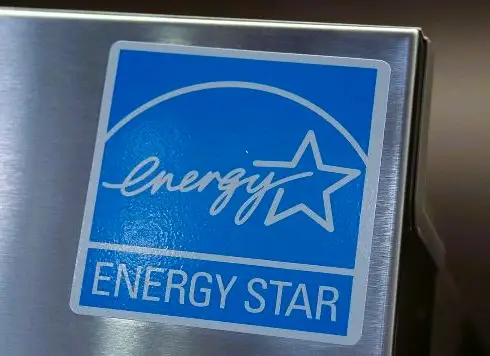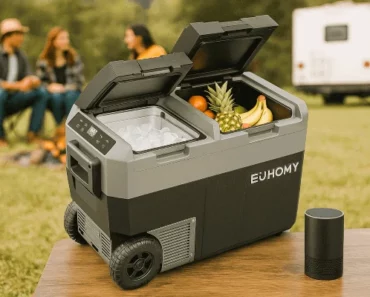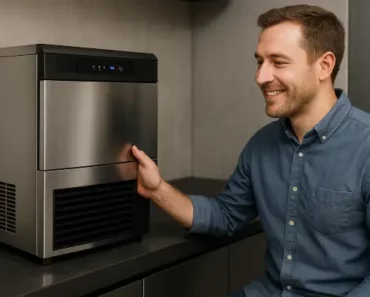How much electricity does an ice maker use? Do ice makers use a lot of electricity? This common question could be the first thing you asked before buying one ice maker, especially when energy costs continue to rise. For the last 10 years, we find an increase of 20% for the energy price; so it is highly advised to buy the ice maker that won’t bankrupt you.
Understanding the power consumption of your ice maker helps manage household or business expenses effectively. Residential countertop ice makers typically consume around 100-150 watts during operation, similar to an LCD TV. However, commercial undercounter models use significantly more electricity, often ranging from 300-500 watts due to their high production capacity.
That’s why to review the power consumption of one ice maker, commonly professionals will count the electricity it needs for producing 100 lbs of ice. Surprisingly, when you calculate the efficiency of the ice maker in that way, many undercounter ice makers will have better power consumption than the countertop ones. You can learn more in my article “Countertop vs undercounter ice makers“.
Monitoring your ice maker’s electricity usage becomes particularly important during summer season when these appliances work harder and consume more power. Being mindful of these factors can substantially reduce your monthly electricity bills. I also made an article on “Does an ice maker use a lot of water?”, so you can calculate the cost for using an ice maker better.
I’ve made a comprehensive “Ice Maker FAQ” series collecting all common ice maker problems to help Ice Artisan readers quickly troubleshoot their ice maker units.
- ⚖️ Countertop vs undercounter ice makers
- 👍 Are portable ice makers worth it?
- ⚡ How much electricity does an ice maker use?
- 💧 Does an ice maker use a lot of water?
- 🪣 Do ice makers need to be drained?
- 🚫 Can ice makers cause water damage?
- 🚰 Do ice makers need water lines?
- 🔊 Are countertop ice makers loud?
- 😭 Do ice makers make a lot of noise?
- 🔗 Are countertop ice makers safe?
- ⛺ Can ice makers be used outdoors?
- 🔌 Can ice makers be left running all the time?
- 🚗 Can ice makers be used in RV?
- 🗄️ Can ice makers be installed in cabinets?
- ❄️ Do portable ice makers keep ice frozen?
- 🛠️ Can ice makers be used in garages?
- 📄 Do ice makers store ice?
- 🚀 How do ice makers make ice so fast?
- 💡 How does ice maker work?
- 🎰 How does a commercial ice maker work?
- 🛠️ How to install an undercounter ice maker?
- ❄️ How to make clear ice in ice maker?
- 🪣 How to increase ice production in ice maker?
- ⏳ How long does an ice maker take to make ice?
- 🔗 When to replace ice maker filter?
- ⏱️ When to replace ice maker?
- 💡 How to clean ice maker?
- 😭 Why does my ice maker smell bad?
- 🫗 How to drain an ice maker?
- 🪣 How to unclog an ice maker?
- 🔗 How do I unstick my ice maker arm?
- 💧 How to fix ice maker leaking water?
- ❄️ Why is my portable ice maker making too much ice?
- 🥵 Why is my ice maker hot?
- 🔌 What happens if you don’t turn off the ice maker?
- 🧊 How to fix ice maker not making ice?
Ice Artisan‘s best picks
How much electricity does an ice maker use?
To help you calculate how much electricity an ice maker use, I compile a code to do your work. Just select the ice maker that you’re looking for, and you will see the result. Convenient, isn’t it?
Ice Maker Electricity Calculator
The most common type is certainly the residential countertop ice maker, that can be found in households across the U.S. These compact ice makers consume relatively modest amounts of electricity, with most models drawing between 100-200 watts during ice production cycles. As a result, the average daily electricity consumption ranges from 1.8-3.5 kWh, and average annual power consumption is about 657-1277 kWh. You need to pay about $210 each year, for the countertop ice maker.
*MOST IMPORTANT: However, the energy consumption of countertop ice makers is assumed when you leave the ice maker running all the time. Instead, the countertop ice maker runs in cycles—only while freezing a new batch of ice. I can only calculate for you base on math, resulting in 1.8-3.5 kWh. The truth is most countertop ice makers actually run for as low as 0.1-0.5 kWh. Read my article “What happens if you don’t turn off the ice maker?” to know why you should turn off the ice maker when unnecessary.
For the business owners who mostly use a commercial, undercounter ice maker, think of the appliance as another refrigerator. The undercounter ice maker typically draws between 300-650 watts when operating, and because of its huge storage, it’s always in operation mode. As a result, the average daily electricity consumption ranges from 5.0-15.6 kWh.

There are some factors that can influence the power consumption of your ice makers. One of these is the ambient temperature, as the ice maker needs to work harder in hotter environments. This factor mostly affect the outdoor commercial ice makers, which increases power needs by up to 30% on hot summer days. To avoid a high electricity bill, consider avoid direct sunlight to the ice maker, and use some sorts of cooler for the area where you installed the ice maker.
Some old ice makers will run on its own, without something to stop them when you don’t need it. Modern ice makers typically have a standby mode when the ice storage is full, or you can schedule when to not run the ice maker. In idle mode, the ice maker consumes very little energy.
One good advice is you should look for an ice maker with Energy Star rating. Ice makers marked with this certification usually have better energy and water consumption to produce the same amount of ice.

Conclusion
Knowing how much electricity does an ice maker use can help you make smarter decisions for your home or business. For lower electricity bills, look for Energy Star certified models, which use up to 25% less power. I also recommend you to know how to clean ice maker, and don’t forget to follow my guide on how to install an undercounter ice maker, which ensures you with better energy consumption.
So do ice makers use a lot of electricity? Yes, but most ice makers won’t significantly impact your energy bill when used normally. Even the commercial ice maker costs far less than a refrigerator, because ice makers aren’t freezers, and they don’t need to keep their storage cold.






